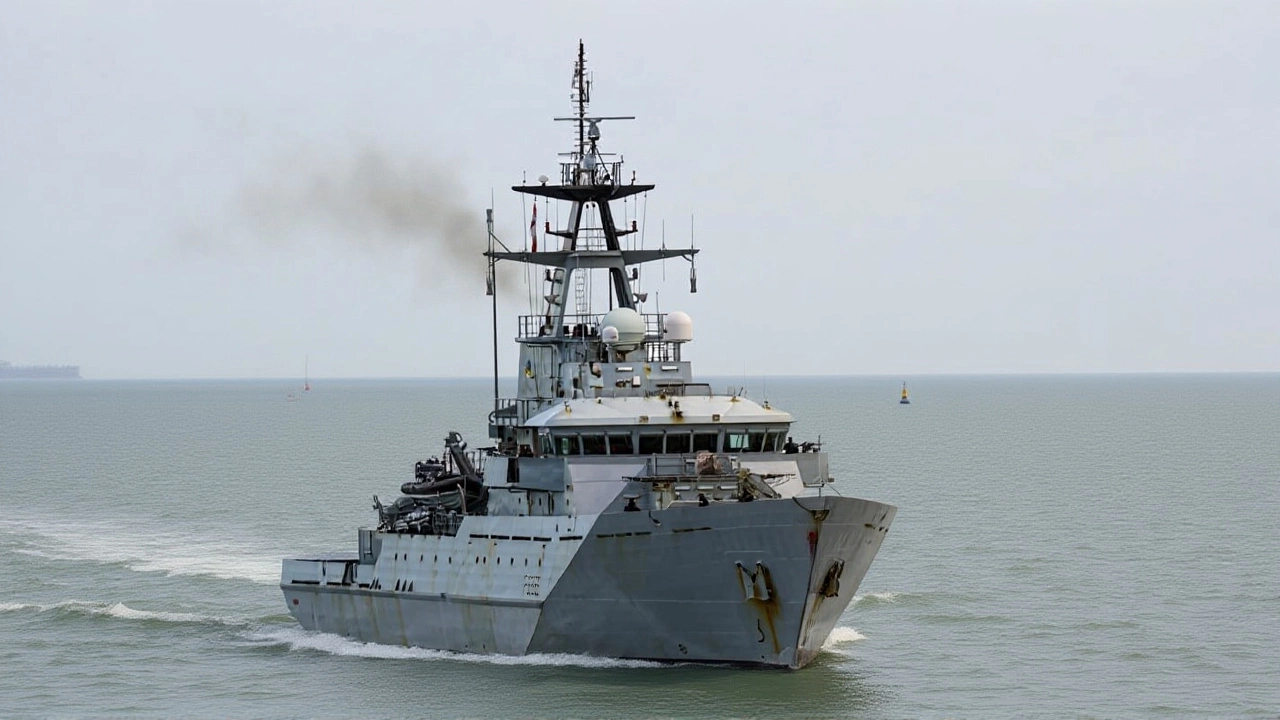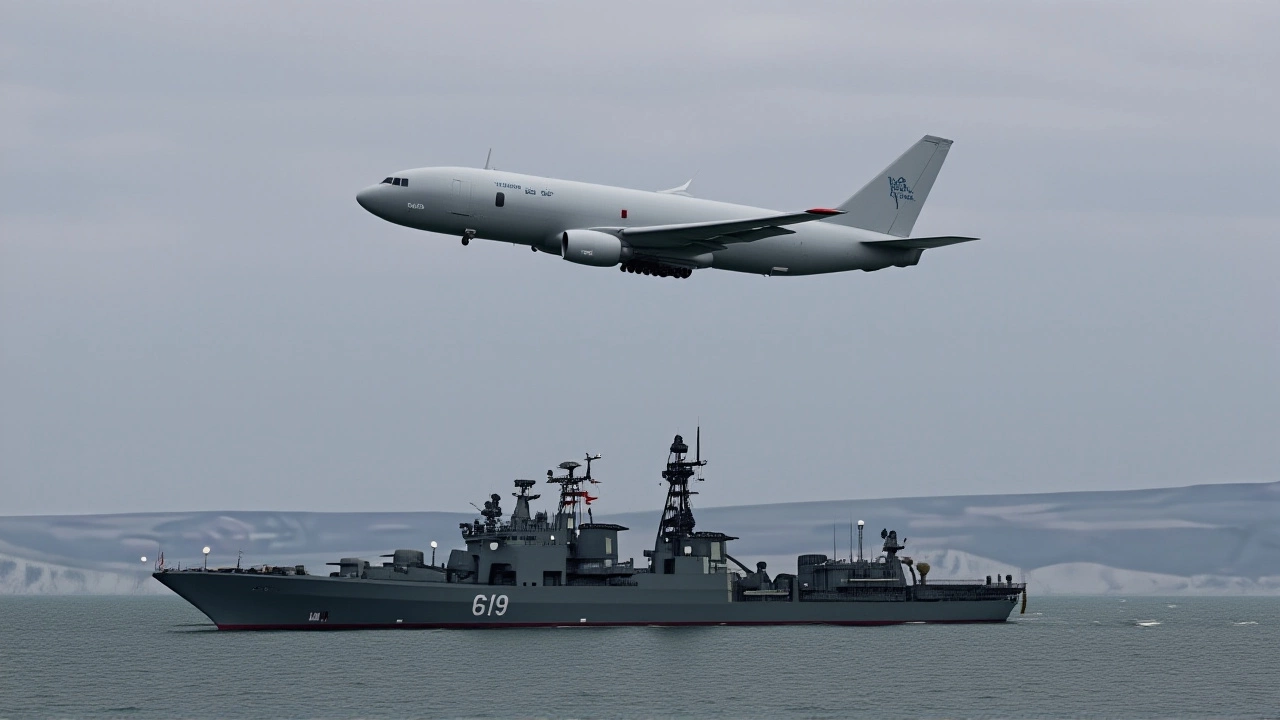On November 19, 2023, the UK sent a clear message to Moscow: we see you. In a rare public declaration, Defence Secretary John Healey confirmed that a Russian spy ship had been lurking near UK waters—while Royal Navy vessels had been shadowing two Russian vessels for two full weeks. The message wasn’t just words. It was backed by real-time surveillance, electronic countermeasures, and a coordinated NATO response that exposed how deeply Russia is probing Britain’s maritime defenses.
Shadowing the Shadowers
The operation began quietly, two weeks before the public announcement. HMS Severn, a 79.5-meter River-class offshore patrol vessel homeported in Portsmouth, was dispatched to track the RFN Stoikiy, a Russian Federation Navy corvette, and the aging Yelnya (IMO: 6813095), a 1968-built Russian-flagged tanker with a 5,045 dwt capacity. The two vessels had entered the Dover Strait, one of the world’s busiest shipping lanes, and were moving westward through the English Channel. For 14 days straight, HMS Severn kept them in sight—day and night, in rough seas and poor visibility—never losing contact.
"This tasking shows the value of our patrol ships," said Commander Grant Dalgleish, HMS Severn’s commanding officer. "I’m immensely proud of the way the ship’s company reacted... especially after a demanding period of regeneration and training." The handover to an unnamed NATO ally occurred off the coast of Brittany, France—roughly 300 nautical miles west of the Channel’s western edge—where surveillance continued without interruption.
Laser Attacks and Electronic Warfare
While HMS Severn was tracking the surface vessels, another threat emerged far to the north. On the same day—November 19, 2023—the Yantar, a Russian intelligence-gathering vessel specially designed to map undersea cables, was spotted operating on the edge of the UK’s exclusive economic zone north of Scotland. Its crew didn’t just observe. They attacked.
According to the UK Ministry of Defence, Yantar’s crew directed high-powered lasers at pilots of RAF P-8 Poseidon aircraft conducting surveillance. "A reckless and dangerous act," the MoD called it. Laser exposure can cause temporary or permanent vision damage, and in a maritime patrol aircraft flying at low altitude, even a momentary flash could be catastrophic.
Simultaneously, the HMS Somerset, a Type 23 frigate operating in the same region, experienced deliberate GPS jamming. "A further demonstration of unprofessional behaviour, intended to be disruptive and a nuisance," the MoD stated. The jamming didn’t disable the frigate’s combat systems—but it was a warning shot across the bow. This wasn’t just espionage. It was electronic warfare.

A 30% Surge in Threats
These incidents didn’t come out of nowhere. Defence Secretary Healey revealed that Russian vessel activity near UK waters has increased by 30 percent over the past two years. That’s not a statistical blip—it’s a strategic shift. The Yantar, built in 1990 and operated by Russia’s Northern Fleet, has been linked to mapping undersea communication cables in the North Atlantic. These cables carry 95% of global internet traffic. Disrupting or tapping them could cripple NATO’s command networks, financial systems, and emergency response coordination.
"We are not just watching. We are ready," Healey said. And the UK is acting. RAF P-8s have been deployed to Keflavik, Iceland, to patrol the North Atlantic. Royal Navy ships maintain a constant presence from the Channel to the High North. The Royal Air Force’s maritime patrol fleet has increased its sortie frequency by nearly 40% since 2022. NATO allies are now sharing real-time data—something that would have been unthinkable just five years ago.
Why This Matters
These aren’t isolated incidents. They’re part of a broader Russian playbook: probe, harass, test defenses, and create ambiguity. The Yelnya tanker? It’s 55 years old. It shouldn’t be operating in strategic waters. But its presence, alongside a modern corvette and a spy ship, suggests Russia is using civilian vessels as cover for military reconnaissance. It’s a gray-zone tactic—legal on paper, dangerous in practice.
And the timing? It’s no coincidence. With NATO preparing for winter readiness drills and tensions rising over Ukraine, Russia is testing how far it can push before triggering a stronger response. The UK’s measured but firm reaction—public statements, continuous patrols, NATO coordination—shows it’s no longer willing to tolerate these provocations as "routine."

What’s Next
The Royal Navy is now planning to expand its patrol fleet in the North Sea and Atlantic, with new River-class vessels entering service by 2025. The MoD is also accelerating the deployment of electronic warfare systems on its frigates and patrol vessels. Meanwhile, NATO has reportedly initiated a new maritime intelligence-sharing protocol called "Project Deepwater," focused on tracking Russian submarine and cable-mapping activity.
One thing is clear: the sea is no longer a quiet frontier. It’s a battlefield—and the UK is no longer just watching from the shore.
Frequently Asked Questions
Why is the Yantar spy ship such a concern?
The Yantar is specifically designed to map undersea communication cables, which carry over 95% of global internet traffic. By identifying their exact locations, Russia could potentially sabotage or tap into them during a crisis—disrupting NATO communications, financial systems, and emergency response networks. Its presence near UK waters isn’t just surveillance; it’s strategic reconnaissance for potential wartime operations.
What’s the significance of the laser attacks on RAF aircraft?
Laser strikes on pilots can cause temporary blindness, disorientation, or permanent eye damage—even at distances over a kilometer. In a maritime patrol aircraft flying low to detect submarines, losing sight for even a few seconds could mean missing a critical target or colliding with terrain. The UK labeled it "reckless" because it endangers lives and violates international norms of air and sea conduct.
How does GPS jamming affect naval operations?
While HMS Somerset’s combat systems remained functional, GPS jamming disrupts navigation, targeting, and coordination with allied forces. Modern warships rely on GPS for precise positioning, especially when firing missiles or coordinating with drones. Repeated jamming forces navies to switch to less accurate backup systems, slowing response times and increasing operational risk.
Why was HMS Severn chosen for this mission?
HMS Severn is one of the Royal Navy’s most versatile patrol vessels—equipped with long-range radar, a helicopter deck, and endurance for 30-day deployments. Its shallow draft allows it to operate close to shorelines and in congested waters like the Dover Strait. Unlike larger frigates, it’s less provocative, making it ideal for persistent, low-profile surveillance without escalating tensions prematurely.
Is this part of a larger Russian strategy?
Yes. Russia has increased naval activity near NATO waters by over 60% since 2021, according to NATO’s annual maritime report. These operations follow a pattern: test defenses, exploit gray zones, use civilian vessels as cover, and provoke without triggering war. The UK’s response signals it’s moving from reactive patrols to proactive deterrence.
What’s the UK planning to do next?
The UK is accelerating the deployment of new River-class patrol vessels, upgrading electronic warfare systems on frigates, and expanding joint NATO maritime exercises in the North Atlantic. By 2025, the Royal Navy aims to have at least three dedicated surveillance vessels permanently stationed in the North Sea and Atlantic, with real-time data sharing with US, Canadian, and Norwegian forces.
